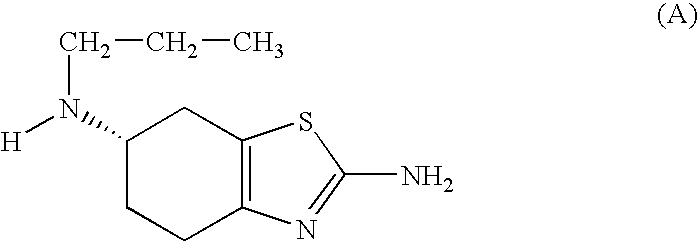Synthesis of intermediates for the preparation of pramipexol
a technology of intermediates and pramipexol, which is applied in the field of synthesis of intermediates for the preparation of pramipexol, can solve the problems of inability to apply industrially, longer production time and higher cost, and difficult enzymatic preparation
- Summary
- Abstract
- Description
- Claims
- Application Information
AI Technical Summary
Benefits of technology
Problems solved by technology
Method used
Image
Examples
example 1
[0051]Enzymatic resolution of an ester of formula (II), R1=ethyl and R=acetylamino, in various cosolvents.
[0052]The enzyme CAL B (0.3 mg) is dissolved in 800 μL of buffer phosphate (pH=7.5; 0.05 M) then a solution of compound (II), wherein R1 is ethyl and R is acetylamino (10 mg) in a cosolvent (200 μL) is added. The reaction is left under stirring at room temperature for a variable time, then is analyzed by HPLC.
[0053]The obtained results are reported in Table 2, in particular: the general conversion of an ester of formula (II) to an acid of formula (I), the enantiomeric excess of the resulting (R) acid of formula (I), and the enantiomeric excess of the (S) ester of formula (II).
[0054]
TABLE 2CosolventTimeee %acid (I)(R)ee %ester (II)(S)ConversionDMF30min83980.52THF3h94950.49CH3CN3h891000.53ACETONE3h801000.55DIOXANE3h881000.53
example 2
[0055]Enzymatic resolution of an ester of formula (II), R1=ethyl, R=acetylamino; in acetonitrile cosolvent with an immobilized lipase.
[0056]The immobilized enzyme CAL B (Novozym® 435) (0.5 mg) is suspended in 800 μL of buffer phosphate (pH=7.5; 0.05 M), then a solution of the compound of formula (II), R1=ethyl and R=acetylamino (10 mg) in acetonitrile (200 μL) is added. The reaction is left under stirring at room temperature for 20 hours, then analyzed by HPLC.
[0057]The obtained results are reported in Table 3, in particular: the general conversion of an ester of formula (II) to an acid of formula (I), the enantiomeric excess of the resulting (R) acid of formula (I), and the enantiomeric excess of the (S) ester of formula (II).
[0058]
TABLE 3Enzymeamounttimeee %acid (I)(R)ee %ester (II)(s)Conversion0.5 mg20 h81970.55
example 3
[0059]Preparation of (S)-2-acetylamino-4,5,6,7-tetrahydro-benzothiazole-6-carboxylic acid. (S) Enantiomer of the acid of formula (I).
[0060]The enzyme CAL B (Novozym® CALB-L) (11 g) is added to 25 ml of ammonium bicarbonate buffer (pH=8.0; 0.37 M), then a solution of the compound of formula (II), R1=ethyl and R=acetylamino (5 g) in THF (25 ml) is added. The reaction is left under stirring at room temperature for 24 hours, then THF is evaporated off. The heterogeneous mixture is added with 25 ml of toluene, then heated to about 40° C., and the formed acid (R) of formula (I) is filtered off. The filtrate is placed in a separatory funnel, the phases are separated and the toluene phase is recovered and added with a solution of NaOH (1 g) in water (12 ml). The mixture is left under stirring for 5-10 hours, after that the aqueous phase is separated, washed with toluene and acidified with acetic acid to approx. pH 5. The formed precipitate is recovered by filtration and dried, to obtain abo...
PUM
| Property | Measurement | Unit |
|---|---|---|
| volume ratio | aaaaa | aaaaa |
| volume ratio | aaaaa | aaaaa |
| temperature | aaaaa | aaaaa |
Abstract
Description
Claims
Application Information
 Login to View More
Login to View More - R&D
- Intellectual Property
- Life Sciences
- Materials
- Tech Scout
- Unparalleled Data Quality
- Higher Quality Content
- 60% Fewer Hallucinations
Browse by: Latest US Patents, China's latest patents, Technical Efficacy Thesaurus, Application Domain, Technology Topic, Popular Technical Reports.
© 2025 PatSnap. All rights reserved.Legal|Privacy policy|Modern Slavery Act Transparency Statement|Sitemap|About US| Contact US: help@patsnap.com



